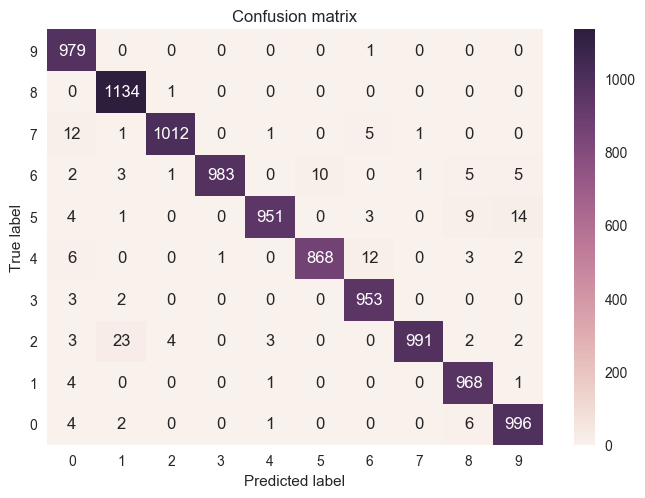MNIST convnet
Published:
MNIST convnet (batch norm, dropout, data augmentation)
Data acquisition and preparation
import numpy as np
import keras
from keras.datasets import mnist
from keras.models import Sequential
from keras.optimizers import Adam
from keras.layers import Dense, Convolution2D, Lambda
from keras.layers import Flatten, MaxPooling2D, BatchNormalization, Dropout
from keras.preprocessing import image
import matplotlib.pyplot as plt
%matplotlib inline
Using Theano backend.
Using gpu device 0: GeForce GTX 860M (CNMeM is disabled, cuDNN 5103)
(X_train, y_train), (X_test, y_test)=mnist.load_data()
X_train=np.expand_dims(X_train,1)
X_test=np.expand_dims(X_test,1)
print(X_train.shape,X_train.dtype)
(60000, 1, 28, 28) uint8
# Preprocessing: substract the mean of the dataset
mean_train=X_train.mean()
print(mean_train.dtype)
#Bad thing! We want float32 to reduce memory use
mean_train=X_train.mean().astype(np.float32)
std_train=X_train.std().astype(np.float32)
def norm_input(x): return (x-mean_train)/std_train
float64
y_test.shape
(10000,)
#Onehot encode the output
from keras.utils.np_utils import to_categorical
def onehot(array):
return to_categorical(array)
y_train=onehot(y_train)
y_test=onehot(y_test)
#Let's visualise the input and the normalised input
plt.figure(figsize=(12,6))
plt.subplot(1,2,1)
n=2
plt.imshow(X_train[n,:,:,:].squeeze().astype(np.uint8),cmap='gray')
plt.title('Regular')
plt.colorbar()
plt.subplot(1,2,2)
plt.title('Normalised')
plt.imshow(norm_input(X_train[n,:,:,:]).squeeze(),cmap='gray')
#They look the same because of the scaling that matplotlib does. Actual values are different
plt.colorbar()
<matplotlib.colorbar.Colorbar at 0x7fb76fe4f780>

# Create a generator to acquire batches from directories
# Training batches are augmented
train_imgs=image.ImageDataGenerator(
rotation_range=8,
width_shift_range=0.08,
height_shift_range=0.08,
shear_range=0.3,
zoom_range=0.08
)
batch_size=64
batch_train=train_imgs.flow(X_train,y_train,batch_size=batch_size)
# Testing batches are not augmented
test_imgs=image.ImageDataGenerator()
batch_test=test_imgs.flow(X_test,y_test,batch_size=batch_size,shuffle=False)
def to_number(array):
return np.asscalar(np.argwhere(array))
def plot_batch(batch,n=4,label=''):
plt.figure(figsize=(12,6))
for i in range(n):
plt.subplot(1,n,i+1)
plt.imshow(batch[0][i,:,:,:].squeeze().astype(np.uint8),cmap='gray')
plt.title(to_number(batch[1][i]))
plot_batch(next(batch_train),10)

Convolutional network definition
#Inputs are (1,28,28)
#border_same to avoid ZeroPadding
class miniNet():
def __init__(self):
self.lr=0.01
self.get_model()
def ConvBlock(self,n):
model=self.model
model.add(Convolution2D(n,3,3,activation='relu',border_mode='same'))
model.add(BatchNormalization(axis=1))
model.add(Convolution2D(n,3,3,activation='relu',border_mode='same'))
model.add(MaxPooling2D())
def FlatBlock(self):
model=self.model
model.add(BatchNormalization())
model.add(Flatten())
model.add(BatchNormalization())
model.add(Dense(512,activation='relu'))
model.add(BatchNormalization(axis=1))
model.add(Dropout(0.4))
model.add(Dense(10,activation='softmax'))
def get_model(self):
self.model=Sequential()
self.model.add(Lambda(norm_input,input_shape=(1,28,28),output_shape=(1,28,28)))
self.ConvBlock(32)
self.ConvBlock(64)
self.FlatBlock()
self.compile()
return self.model
def fit(self,train_batch,val_batch,nb_epoch=1):
self.model.fit_generator(train_batch,nb_epoch=nb_epoch,
validation_data=val_batch,
nb_val_samples=val_batch.N,
samples_per_epoch=train_batch.N)
def summary(self):
self.model.summary()
def set_lr(self,lr):
self.lr=lr
self.model.optimizer.lr=lr
def compile(self,lr=0.01):
self.model.compile(Adam(lr=self.lr),loss='categorical_crossentropy',metrics=['accuracy'])
CN=miniNet()
CN.summary()
#CN.fit(batch_train,batch_test,1)
____________________________________________________________________________________________________
Layer (type) Output Shape Param # Connected to
====================================================================================================
lambda_30 (Lambda) (None, 1, 28, 28) 0 lambda_input_30[0][0]
____________________________________________________________________________________________________
convolution2d_117 (Convolution2D)(None, 32, 28, 28) 320 lambda_30[0][0]
____________________________________________________________________________________________________
batchnormalization_146 (BatchNorm(None, 32, 28, 28) 64 convolution2d_117[0][0]
____________________________________________________________________________________________________
convolution2d_118 (Convolution2D)(None, 32, 28, 28) 9248 batchnormalization_146[0][0]
____________________________________________________________________________________________________
maxpooling2d_59 (MaxPooling2D) (None, 32, 14, 14) 0 convolution2d_118[0][0]
____________________________________________________________________________________________________
convolution2d_119 (Convolution2D)(None, 64, 14, 14) 18496 maxpooling2d_59[0][0]
____________________________________________________________________________________________________
batchnormalization_147 (BatchNorm(None, 64, 14, 14) 128 convolution2d_119[0][0]
____________________________________________________________________________________________________
convolution2d_120 (Convolution2D)(None, 64, 14, 14) 36928 batchnormalization_147[0][0]
____________________________________________________________________________________________________
maxpooling2d_60 (MaxPooling2D) (None, 64, 7, 7) 0 convolution2d_120[0][0]
____________________________________________________________________________________________________
batchnormalization_148 (BatchNorm(None, 64, 7, 7) 14 maxpooling2d_60[0][0]
____________________________________________________________________________________________________
flatten_30 (Flatten) (None, 3136) 0 batchnormalization_148[0][0]
____________________________________________________________________________________________________
batchnormalization_149 (BatchNorm(None, 3136) 6272 flatten_30[0][0]
____________________________________________________________________________________________________
dense_59 (Dense) (None, 512) 1606144 batchnormalization_149[0][0]
____________________________________________________________________________________________________
batchnormalization_150 (BatchNorm(None, 512) 1024 dense_59[0][0]
____________________________________________________________________________________________________
dropout_30 (Dropout) (None, 512) 0 batchnormalization_150[0][0]
____________________________________________________________________________________________________
dense_60 (Dense) (None, 10) 5130 dropout_30[0][0]
====================================================================================================
Total params: 1683768
____________________________________________________________________________________________________
#CN.model.save_weights('weights.pkl')
#CN.model.load_weights('weights.pkl')
# CN.set_lr(0.1)
# CN.fit(batch_train,batch_test,1)
# CN.set_lr(0.001)
# CN.fit(batch_train,batch_test,3)
#CN.model.save_weights('weights_fine.pkl')
CN.model.load_weights('weights_fine.pkl')
Prediction and confusion matrix
#Predictions
def to_number_a(array):
if array.ndim>1:
return np.nonzero(array)[1]
else:
return np.nonzero(array)[0][0]
preds=CN.model.predict_classes(X_test,batch_size=64)
probs=CN.model.predict_proba(X_test,batch_size=64)
ntest_y=to_number_a(y_test)
7680/10000 [======================>.......] - ETA: 0s
X_train.shape
(60000, 1, 28, 28)
probs[0]
array([ 1.54e-09, 2.53e-08, 2.89e-09, 2.90e-11, 1.64e-11, 2.35e-13, 1.92e-14,
1.00e+00, 8.17e-12, 9.74e-09], dtype=float32)
# Some wrong items
n_preds=3
incorrect=np.where(preds!=ntest_y)[0]
from numpy.random import random, permutation
n_items=4
idx=permutation(incorrect)[:n_items]
def plot_idx(idx,n=4):
plt.figure(figsize=(12,6))
for i,img in enumerate(idx):
plt.subplot(1,n,i+1)
plt.imshow(X_test[img,:,:,:].squeeze(),cmap='gray')
plt.gca().grid(False)
plt.gca().get_yaxis().set_ticks([])
plt.gca().get_xaxis().set_ticks([])
substring='Probabilities of:\n'
order=np.argsort(probs[img])[::-1][:n_preds]
top=probs[img][order]
for j in range(n_preds):
substring+='{:d}: {:.2f}\n'.format((order[j]),(top[j]))
plt.xlabel(substring)
plt.title('True label: '+str(ntest_y[img])+'\nPredicted label: '+str(preds[img]))
#plt.title(to_number(batch[1][i]))
plot_idx(idx,n_items)

# Some correct items
correct=np.where(preds==ntest_y)[0]
n_items=4
idx=permutation(correct)[:n_items]
plot_idx(idx,n_items)

# Items that were highly uncertain
n_items=4
#This gives us the rows that have uncertain labels
most_uncertain=np.argsort(probs.std(axis=1))
np.set_printoptions(precision=2, linewidth=100)
print(probs[most_uncertain,0])
idx=permutation(most_uncertain[:n_items] )
plot_idx(idx,n_items)
[ 1.75e-01 4.77e-02 9.49e-02 ..., 1.89e-11 4.63e-15 3.33e-09]

#Confusion matrix
print(to_number_a(y_test))
from sklearn.metrics import confusion_matrix
cm=confusion_matrix(ntest_y,preds)
import seaborn as sns
p=sns.heatmap(cm,annot=True,fmt='d')
p.set_yticklabels(range(10),rotation=0)
plt.xlabel('Predicted label')
plt.ylabel('True label')
plt.title('Confusion matrix')
[7 2 1 ..., 4 5 6]
<matplotlib.text.Text at 0x7fb7601dee10>

Ensembling and prediction
class Ensemble():
def __init__(self,n=2):
self.n=n
self.create(n)
def create(self,n=n):
self.models=[miniNet() for i in range(n) ]
def fit(self,train_batch,val_batch,nb_epoch=1):
for model in self.models:
model.fit(train_batch,val_batch,nb_epoch=nb_epoch)
def predict_proba(self,X_test,batch_size=64):
self.probas=np.stack([model.model.predict_proba(X_test,batch_size=batch_size)
for model in self.models])
return self.probas.mean(axis=0)
def save_weights(self):
for i,model in enumerate(self.models):
model.model.save_weights('mnist_ensemble_submodel'+str(i))
def load_weights(self):
for i,model in enumerate(self.models):
model.model.load_weights('mnist_ensemble_submodel'+str(i))
def evaluate(self,X_test,y_test,batch_size=64):
for model in self.models:
loss,acc=model.model.evaluate(X_test,y_test,batch_size=batch_size)
print('\nLoss:{:.3f} Accuracy:{:.3f}'.format(loss,acc))
def long_fit(self,train_batch,val_batch,epoch_1=1,epoch_2=3):
for model in self.models:
model.set_lr(0.01)
model.fit(train_batch,val_batch,epoch_1)
model.set_lr(0.0001)
model.fit(train_batch,val_batch,epoch_2)
ens=Ensemble()
#ens.load_weights()
#A learning rate of 0.001 seems too high, it explodes after a few iterations.
ens.long_fit(batch_train,batch_test,1,1)
ens.save_weights()
Epoch 1/1
60000/60000 [==============================] - 75s - loss: 0.2538 - acc: 0.9292 - val_loss: 0.0672 - val_acc: 0.9808
Epoch 1/1
60000/60000 [==============================] - 82s - loss: 0.1050 - acc: 0.9686 - val_loss: 0.0455 - val_acc: 0.9862
Epoch 1/1
60000/60000 [==============================] - 79s - loss: 0.2515 - acc: 0.9303 - val_loss: 0.1366 - val_acc: 0.9631
Epoch 1/1
60000/60000 [==============================] - 82s - loss: 0.1141 - acc: 0.9668 - val_loss: 0.0639 - val_acc: 0.9802
#Performance of individual models
ens.evaluate(X_test,y_test)
9216/10000 [==========================>...] - ETA: 0s
Loss:0.046 Accuracy:0.986
9664/10000 [===========================>..] - ETA: 0s
Loss:0.064 Accuracy:0.980
keras.metrics.categorical_accuracy(y_test, ens.predict_proba(X_test)).eval()
7744/10000 [======================>.......] - ETA: 0s
array(0.9904000163078308, dtype=float32)
Individual models are up to 0.986 accurate. The ensemble mode goes up to 0.99. This is just with two models and not much training.
